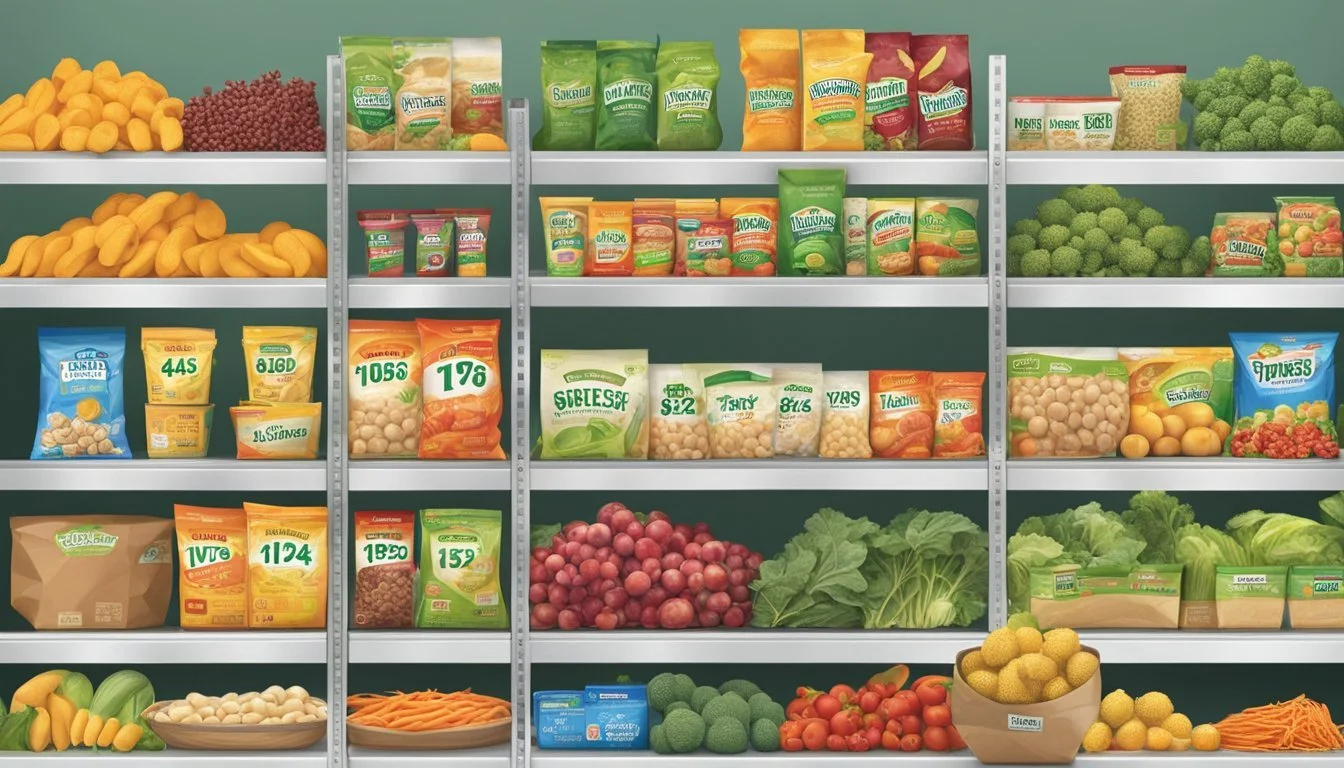Is Hy-Vee Cheaper Than Sprouts?
Comparing Grocery Prices
Part of Our Grocery Store Guide with Details on Hy-Vee Prices and Sprouts Farmers Market Prices
When it comes to grocery shopping, customers often have a primary concern: finding the best prices for their everyday items. Supermarket chains such as Hy-Vee and Sprouts cater to different segments of the market, but for many shoppers, the decision of where to buy comes down to cost-effectiveness. Hy-Vee, a mainstay in the Midwest with approximately 285 stores, is known for its wide selection and store-brand products. On the other hand, Sprouts, with its focus on healthy living and fresh produce, appeals to a different customer base; yet, price comparisons are still essential to budget-conscious consumers.
Investigating whether Hy-Vee is cheaper than Sprouts requires a nuanced look at their pricing strategies. Hy-Vee has established a reputation for offering competitive prices, especially with their store-brand items that are said to rival national brands in quality and taste while maintaining affordability. In contrast, Sprouts, while having a reputation for higher quality, particularly in organic and natural products, has also come under scrutiny for its pricing. A review comparing these two grocery stores is illuminating not just for individual customers looking to stretch their dollar but also for illustrating the varied pricing approaches within the grocery industry.
Pricing Comparison Overview
In the competitive grocery market, consumers often seek the best value for their household budgets, scrutinizing prices across stores. This section specifically examines how Hy-Vee's pricing stacks up against Sprouts Farmers Market.
Understanding Retail Pricing Strategies
Hy-Vee and Sprouts Farmers Market employ distinct pricing strategies that reflect their brand positioning and target markets. Hy-Vee, a long-standing Midwest chain, aims to offer a wide range of products that includes conventional and gourmet items, which may affect their price points. Sprouts, with a focus on natural and organic products, often provides competitive pricing in these categories to appeal to health-conscious shoppers. These strategies are designed to build customer loyalty and position each store in unique segments of the grocery industry.
It's important to consider that retail pricing strategies are influenced by factors that include but are not limited to:
Location: Regional cost of living and store density can sway prices.
Product Types: Organic and specialty products typically command higher prices.
Volume: Buying and selling in larger volumes can lead to lower prices.
Factors Influencing Grocery Prices
Surveys play a crucial role in revealing the landscape of grocery pricing, indicating where consumers might find lower prices for their grocery lists. Data suggests stores like Walmart, Aldi, and Target have been found to offer competitive prices, often averaging lower than industry standards for a wide variety of items. Here's a simple breakdown of key entities influencing grocery prices:
Economies of Scale: Larger retailers such as Walmart may leverage bulk purchasing to offer lower prices.
Brand Types: Generic or store-brand items, which are often cheaper, might skew overall perceptions of store pricing toward affordability.
Sales Frequency: Regular promotions and discounts can temporarily alter price comparisons.
Location-Specific Factors: Taxes, real estate costs, and local competition can impact grocery pricing.
Examining Hy-Vee's and Sprouts' prices requires a nuanced approach that considers both the diversity of their product lines and the retail environments in which they operate.
Exploring Store Brands and Product Selection
When comparing Hy-Vee and Sprouts Farmers Market, a key point of differentiation is their respective store brands and the range of products they offer. Both prioritize quality and cater to consumers seeking organic and natural options, though their approaches to product selection and branding vary.
Benefits of Store Brands
Hy-Vee's store brand products are marketed as comparable in taste and quality to national brands, often at a reduced cost. A store brand can provide significant savings for shoppers, with the potential to be up to 20% cheaper on staple items. Sprouts also offers an extensive selection of store brands, focusing on organic and natural products to align with its health-conscious branding.
Cost-effective: Store brands like Hy-Vee's SE Grocers often represent better value.
Quality: Both Hy-Vee and Sprouts maintain high quality standards for their store brands, competing with national labels.
Scope of Product Lines
Hy-Vee features a variety of store concepts that cater to different needs, including a focus on speciality needs, organics, and convenience. They offer a diverse selection of products that covers everyday items from white sandwich bread to raw chicken meat. Sprouts, with its focus on health, heavily stocks organic produce and natural foods, offering a wide range in these categories.
Hy-Vee:
Range: Offers both basic and specialty items.
Diversity: Caters to various consumer needs including organics.
Sprouts:
Specialization: Prioritizes organic and natural food lines.
Produce: Known for a robust selection of fresh, organic produce.
Quality Standards of Products
Both stores set rigorous quality standards for their offerings, be it store brands or otherwise. Hy-Vee, for example, positions some of its store brand items as equal to or better than competing national brands in quality. Products such as their light ice cream and coarse ground mustard are highlighted for their comparable or superior quality. Sprouts reinforces its dedication to quality through a vast array of organic foods, ensuring that shoppers have access to fresh and wholesome options.
Hy-Vee:
Standards: Matches or exceeds national brands.
Examples: Ice cream and mustard with long shelf lives and gourmet taste profiles.
Sprouts:
Organic Commitment: Strong focus on high-quality, certified organic options.
Assurance: Organic and natural standards are a cornerstone of their product selection.
Assessing Produce and Meat Departments
In comparing Hy-Vee and Sprouts Farmers Market, consumers often weigh the balance of cost and quality in the produce and meat departments, which are pivotal in making a choice between the two retailers.
Quality and Variety of Produce
Hy-Vee and Sprouts Farmers Market both offer a range of fresh produce options. Sprouts is recognized for its focus on healthy living, typically offering a wide array of organic and natural fruits and vegetables. Hy-Vee, on the other hand, provides a diverse selection that includes both conventional and organic produce, though specific offerings can vary by location. Customers can expect to find everything from staple vegetables to seasonal fruits.
Meat Selection and Pricing
When it comes to meats, both Hy-Vee and Sprouts boast quality offerings. Hy-Vee's meat counter provides customers with a variety of options including chicken, beef, pork, and seafood. The pricing of meats at Hy-Vee can be competitive depending on store promotions and discounts. In contrast, Sprouts often positions itself as a supplier of natural and organic meats, which may cater to a specific customer segment looking for these attributes. However, this can also be reflected in the pricing, which might be higher compared to traditional offerings.
Specialized Departments and Offerings
In comparing Hy-Vee and Sprouts Farmers Market, one finds distinct differences in their specialized departments and offerings that cater to various consumer needs from fresh, ready-to-eat meals to organic and health-conscious selections.
Deli and Bakery Counter
Hy-Vee features a comprehensive deli and bakery section with a diverse array of products. Customers can find a variety of deli meats, cheeses, and freshly made salads. Their bakery offers an assortment of baked goods, including freshly baked breads, pastries, and custom cakes, positioning itself as a one-stop shop for both everyday needs and special occasions.
Organic and Health Foods
Sprouts Farmers Market emphasizes its organic and health food selections. It provides a wide range of organic options across various departments, including dairy and fresh produce, appealing to health-conscious consumers and those following specific diets. Sprouts is well-known for its fresh market atmosphere and for stocking a plethora of whole foods and healthy alternatives.
Prepared Foods and Deli Selection
Both stores offer prepared foods and deli selections, but Hy-Vee often leads with its prepared food counters, featuring ready-to-eat meals which are convenient for customers seeking quick and satisfying options. Meanwhile, Sprouts maintains a selection that includes healthy and organic prepared options, although it is more focused on ingredients for meal preparation rather than fully prepared dishes.
Comparing Promotions and Discounts
In the competitive grocery industry, Hy-Vee and Sprouts offer various promotions and discounts to attract customers. This section will highlight how each store approaches savings at checkout, affecting a shopper's grocery budget.
Regular Discounts and Sales
Hy-Vee is known for its weekly sales, seasonal promotions, and discount deals across various departments. Customers can often find savings on a wide range of products, which are advertised through their flyers and in-store signage. Sprouts, on the other hand, emphasizes its regular discounts on fresh, natural, and organic products. Both stores offer a rotating selection of deals, which can significantly impact a customer's ability to save.
Hy-Vee: Weekly Ads, Special Deals
Sprouts: Deals of the Month, Weekly Specials
Loyalty Programs and Savings
Hy-Vee’s loyalty program is designed to provide customers with additional savings opportunities. By signing up for the Hy-Vee Plus membership, shoppers gain access to exclusive deals, fuel discounts, and monthly freebies.
Sprouts, however, does not have a traditional loyalty program but encourages customers to take advantage of its digital coupons and mobile app, which offer exclusive discounts and a streamlined shopping experience.
Hy-Vee Plus:
Exclusive member deals
Fuel savings
Monthly free products
Sprouts Digital Coupons:
App-specific deals
Instant savings at checkout
Consumer Experience and Store Layout
When comparing Hy-Vee and Sprouts Farmers Market, the consumer experience and store layout are discernible factors. They contribute significantly to the overall shopping experience, from how customers navigate the aisles to the services provided at checkout.
Shopping Ambiance and Navigation
Hy-Vee stores have been reimagining their layouts to integrate technology and boost the shopping ambiance. Their recent designs feature all-digital shelf labels for pricing, facilitating a more tech-forward grocery shop. This not only appeals to the tech-savvy customer but also streamlines the shopping experience by making price checks and product information easily accessible. On the other hand, Sprouts Farmers Market emphasizes a farmers market atmosphere, with a focus on fresh produce and natural foods. Their layout encourages customers to explore and discover new products, emulating the experience of shopping in an open-air market.
Customer Service and Satisfaction
Customer service is a pivotal point of distinction. Hy-Vee takes pride in its variety of services that enhance convenience, such as online ordering and curbside pickup options. Their commitment to customer service aims to ensure satisfaction during each visit. Sprouts also aims to deliver a high level of customer service with knowledgeable staff, especially in specialized areas like vitamins and supplements. Both stores prioritize efficient checkout processes to reduce wait times and improve the grocery shopping conclusion.
In the realm of grocery stores, the attention dedicated to store layout and the customer experience significantly impacts how shoppers perceive and value their grocery shopping. Hy-Vee and Sprouts Farmers Market cater to their customers’ needs with their unique store designs and service offerings, shaping the way consumers conduct their grocery shopping.
Geographic Accessibility and Location
When comparing Hy-Vee and Sprouts Farmers Market, one key aspect to consider is the geographic distribution of their stores and how it impacts customers.
Store Presence in Different Regions
Hy-Vee predominantly operates in the Midwest, with a store count exceeding 265 locations. Their presence is particularly strong in regions like Chicago, serving as a staple supermarket option for many Midwestern shoppers due to its extensive reach.
Sprouts Farmers Market, on the other hand, has carved out a significant presence across the United States with approximately 356 stores spanning 23 states. Sprouts does not have as concentrated a presence in the Midwest as Hy-Vee, but it does cater to a broader national footprint, offering health-conscious consumers a variety of specialty and organic products.
Supermarket Strength of Presence in the Midwest National Reach Hy-Vee Strong Mainly Midwest Sprouts Moderate Wide, across 23 states
Both supermarkets have established strong brands in their respective regions, Hy-Vee with a focus on the Midwest market, and Sprouts serving a more national customer base.
Analysis of Demographic Targeting
When comparing Hy-Vee and Sprouts, it’s essential to consider how each supermarket targets its demographic. Both have distinct marketing strategies that cater to different segments of the grocery store market, particularly families and health-conscious customers.
Family-Oriented Marketing
Hy-Vee has traditionally positioned itself as a family-focused grocery store, tailoring its marketing to attract families seeking convenience and a variety of options.Discounts and weekly specials are a common part of their strategy, aimed at budget-conscious households. Their large store layout often includes diversified departments which offer a broad selection catering to the whole family, from organic foods to general merchandise.
Appealing to Health-Conscious Shoppers
On the other hand, Sprouts markets itself heavily to health-conscious shoppers. This grocery store chain emphasizes fresh, organic foods, providing a well-curated selection of produce and health-oriented products. The appeal here is to customers who prioritize healthy eating, which is reflected in Sprouts' product range that includes natural and non-genetically modified offerings. Although some healthy options are usually available at competitive prices, the overall pricing at Sprouts can be higher compared to some of Hy-Vee’s selections.
Overall Cost Efficiencies
When comparing Hy-Vee to Sprouts, it's important for consumers to examine how bulk purchasing options and the average total of grocery bills influence their overall savings.
Bulk Purchasing and Price Per Unit
At Hy-Vee, the options for purchasing items in bulk can affect cost efficiency. Products priced per pound or per unit may offer savings when bought in larger quantities. Consumers should compare the price per unit when considering savings, as bulk purchasing at Hy-Vee could lead to a lower cost per unit than Sprouts, affecting the overall grocery budget. For instance:
Bulk rice at Hy-Vee might be
$0.50per pound, while Sprouts could be higher.A shopper buying 20 pounds of rice could save more at Hy-Vee, assuming the price per unit remains consistent.
Comparing Average Grocery Bills
An analysis of average grocery bills is a telling factor of overall cost efficiency. Shoppers should evaluate their receipts from both Hy-Vee and Sprouts to assess where they could potentially save.
Average bill for a family of four at Hy-Vee:
$200Average bill for the same family at Sprouts:
$230
Savings per week for the family shopping at Hy-Vee, in this case, would be $30. Over a month, the savings could add up to $120, thereby reflecting Hy-Vee's potential cost-effectiveness for a regular grocery budget.
Branding and Market Position
In the competitive grocery market, branding and market position play crucial roles in influencing consumer preference and shopping patterns. Hy-Vee and Sprouts have distinct identities that cater to different segments of the market.
Brand Perception and Trust
Hy-Vee is known for its strong Midwestern roots, often perceived as a community-centric brand with a focus on customer service. It ranks highly in consumer trust, with management at each store given the authority to set their own prices, enabling them to cater specifically to local community needs. This autonomy can positively impact local brand loyalty and trust.
Hy-Vee: Regarded for customer service; possesses regional market strength.
Sprouts: Seen as a health-oriented grocery chain, appealing to health-conscious consumers.
Sprouts, on the other hand, markets itself as a healthy grocery store, specializing in fresh, natural, and organic products. This branding approach resonates well with health-conscious consumers and those looking for specialty items. Sprouts' brand perception is centered around wellness, which can lead to a dedicated customer base that trusts the chain for quality health-focused products.
Competition with Other Grocery Chains
In terms of competition with other grocery chains, Hy-Vee faces rivals like Walmart and Kroger, which offer lower prices and larger market shares nationally. Despite this, Hy-Vee maintains a competitive edge in the Midwest by offering diverse store formats and a personalized shopping experience.
Hy-Vee: Competes through diverse store concepts, including traditional grocery stores and specialty outlets.
Walmart: Known for best overall value; leads in price competitiveness.
Kroger: Praised for combining variety and value; strong presence across the US.
Sprouts, on its part, is often compared to chains like Whole Foods Market and Trader Joe’s. While Whole Foods is known for its wide selection of organic products, Sprouts distinguishes itself with competitive pricing on similar product lines. Trader Joe's has a strong brand following due to its unique product offerings and pricing strategy. Sprouts aims to balance affordability with health-centric offerings to maintain its market position.
Sprouts: Offers organic and natural products at competitive prices.
Whole Foods Market: Attracts consumers with a wide range of organic and specialty items.
Trader Joe’s: Engages customers with its unique branding and product selection.
Both Hy-Vee and Sprouts understand their respective customer bases, tailoring their market approaches to align with their consumers' expectations and preferences. They constantly adapt to retain and grow their market positions by emphasizing their unique brand propositions in the grocery retail landscape.
Conclusion
Upon comparing Sprouts and Hy-Vee in terms of pricing and quality, it is evident that shoppers' experiences may vary based on their shopping patterns and the types of items they purchase. Hy-Vee has been criticized for higher non-sale prices, which could impact the perception of its value. Conversely, Sprouts often offers competitive prices, especially for produce, but might be outdone by Hy-Vee for certain promotional items or store brands.
In terms of quality, both grocery stores have strong brand reputations. Sprouts markets itself as a healthy grocery store that specializes in fresh, natural, and organic products, while Hy-Vee is known to provide a wide range of groceries and a focus on customer service.
For consumers looking to maximize savings, it may be beneficial to be selective about where they purchase specific items:
Produce might often be more affordable at Sprouts.
Everyday items and store brands could present better value at Hy-Vee.
Ultimately, the choice between Hy-Vee and Sprouts may come down to personal preferences on the balance of price versus quality, as well as convenience and individual shopping needs.
Item Type Suggested Store Produce Sprouts Store Brands Hy-Vee Overall Savings Depends on Items and Promotions at Each Store
Shoppers should consider their budgets and culinary preferences when choosing their preferred grocery store. Whether the aim is to cut costs or to enjoy a certain quality of groceries, both stores provide distinct offerings that cater to various consumer needs.













